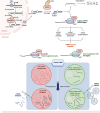MicroRNA in cancer therapy: breakthroughs and challenges in early clinical applications
- PMID: 40259326
- PMCID: PMC12010629
- DOI: 10.1186/s13046-025-03391-x
MicroRNA in cancer therapy: breakthroughs and challenges in early clinical applications
Abstract
MicroRNAs (miRNAs) have emerged as pivotal regulators in cancer biology, influencing tumorigenesis, progression, and resistance to therapy. Their ability to modulate multiple oncogenic and tumor-suppressive pathways positions them as promising therapeutic tools or targets. This review examines the dual role of miRNAs in solid and hematological malignancies, starting from their dysregulation in various cancer types. Therapeutic approaches, including miRNA replacement and inhibition strategies, are discussed alongside innovative delivery systems such as lipid nanoparticles and exosomes. Despite their transformative potential, challenges persist, including off-target effects, immune activation, and delivery inefficiencies. Recent clinical trials demonstrate both progress and hurdles, underscoring the need for advanced strategies to optimize specificity and minimize toxicity. This review provides an updated comprehensive overview of the current landscape of miRNA-based therapies under early clinical investigation and explores future directions for integrating these approaches into precision oncology.
Keywords: Clinical trials; Early clinical trials; First-in-human; LNA; Locked nucleic acid; Non-coding RNA; Phase 1; miRNA; miRNA inhibitor; miRNA therapeutics; microRNA; ncRNA.
© 2025. The Author(s).
Conflict of interest statement
Declarations. Ethics approval and consent to participate: Not applicable. Consent for publication: All the authors agree to publish this paper. Competing interests: The authors declare no competing interests.
Figures


Similar articles
-
Trials and Tribulations of MicroRNA Therapeutics.Int J Mol Sci. 2024 Jan 25;25(3):1469. doi: 10.3390/ijms25031469. Int J Mol Sci. 2024. PMID: 38338746 Free PMC article. Review.
-
Progress in microRNA delivery.J Control Release. 2013 Dec 28;172(3):962-74. doi: 10.1016/j.jconrel.2013.09.015. Epub 2013 Sep 25. J Control Release. 2013. PMID: 24075926 Free PMC article. Review.
-
microRNA Therapeutics in Cancer - An Emerging Concept.EBioMedicine. 2016 Oct;12:34-42. doi: 10.1016/j.ebiom.2016.09.017. Epub 2016 Sep 20. EBioMedicine. 2016. PMID: 27720213 Free PMC article. Review.
-
miRNA and cancer; computational and experimental approaches.Curr Pharm Biotechnol. 2014;15(5):429. doi: 10.2174/138920101505140828161335. Curr Pharm Biotechnol. 2014. PMID: 25189575
-
Advances in MicroRNA Therapeutics: From Preclinical to Clinical Studies.Hum Gene Ther. 2024 Sep;35(17-18):628-648. doi: 10.1089/hum.2024.113. Hum Gene Ther. 2024. PMID: 39150011 Review.
Cited by
-
Upregulation of miR-200c and miR-429 Suggests Reversal Towards Epithelial State in Venous Tumour Thrombus of Clear Cell Renal Cell Carcinoma.Int J Mol Sci. 2025 Aug 18;26(16):7951. doi: 10.3390/ijms26167951. Int J Mol Sci. 2025. PMID: 40869272 Free PMC article.
-
Silencing epileptic storms: targeting miRNA-lncRNA crosstalk in astrocytes and microglia to disarm neuroinflammatory triggers.Front Mol Neurosci. 2025 Jul 28;18:1616804. doi: 10.3389/fnmol.2025.1616804. eCollection 2025. Front Mol Neurosci. 2025. PMID: 40791576 Free PMC article. Review.
-
Bioinformatics identification of key microRNA-correlated genes associated with hepatocellular carcinoma heterogeneity and prognosis.BMC Gastroenterol. 2025 Jul 1;25(1):452. doi: 10.1186/s12876-025-04031-6. BMC Gastroenterol. 2025. PMID: 40596892 Free PMC article.
-
MicroRNA‑21: A potential therapeutic target in lung cancer (Review).Int J Oncol. 2025 Aug;67(2):67. doi: 10.3892/ijo.2025.5773. Epub 2025 Jul 11. Int J Oncol. 2025. PMID: 40641110 Free PMC article. Review.
-
The Multifaceted Role of miR-211 in Health and Disease.Biomolecules. 2025 Aug 1;15(8):1109. doi: 10.3390/biom15081109. Biomolecules. 2025. PMID: 40867554 Free PMC article. Review.
References
-
- Siegel RL, Miller KD, Jemal A. Cancer statistics, 2020. CA Cancer J Clin. 2020;70(1):7–30. - PubMed
-
- Sung H, Ferlay J, Siegel RL, Laversanne M, Soerjomataram I, Jemal A, Bray F. Global Cancer statistics 2020: GLOBOCAN estimates of incidence and mortality worldwide for 36 cancers in 185 countries. CA Cancer J Clin. 2021;71(3):209–49. - PubMed
-
- He L, Hannon GJ. MicroRNAs: small RNAs with a big role in gene regulation. Nat Rev Genet. 2004;5(7):522–31. - PubMed
-
- Hayes J, Peruzzi PP, Lawler S. MicroRNAs in cancer: biomarkers, functions and therapy. Trends Mol Med. 2014;20(8):460–9. - PubMed
Publication types
MeSH terms
Substances
LinkOut - more resources
Full Text Sources
Medical

